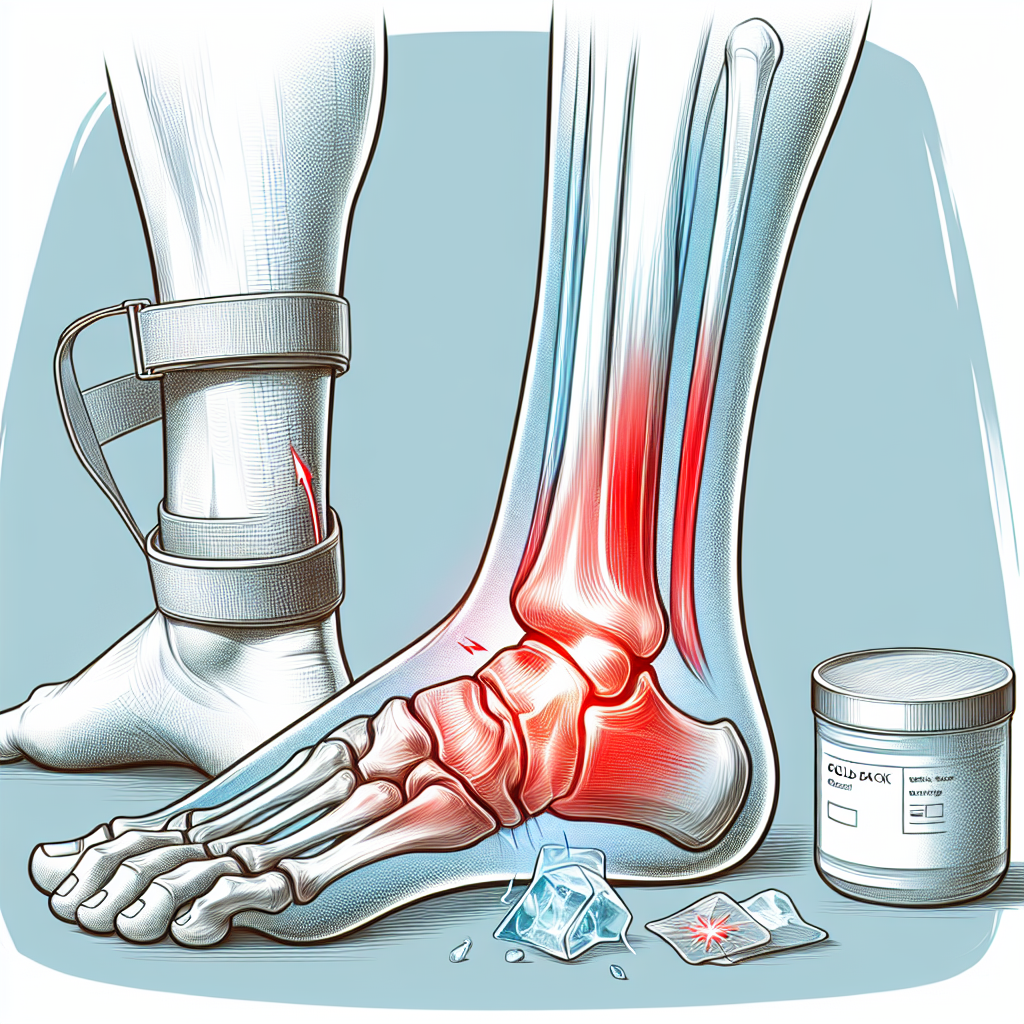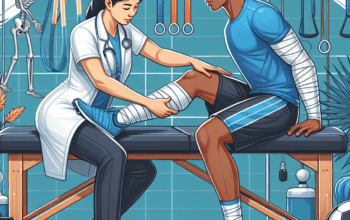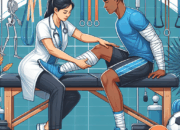How to Recognize and Treat a Sprained Ankle: A Comprehensive Guide
A sprained ankle is a common injury that can happen unexpectedly, whether during sports or simply walking on uneven surfaces. Understanding how to recognize the symptoms and the best treatment options can make a significant difference in healing time and minimizing long-term effects. In this guide, we will explore how to identify a sprained ankle, the treatment methods available, and preventive measures you can take to avoid future injuries.
Recognizing a Sprained Ankle: Key Symptoms
When it comes to recognizing a sprained ankle, it’s essential to be aware of the primary symptoms. A sprain occurs when the ligaments connecting the bones in the ankle are overstretched or torn. This injury can happen due to a variety of causes, including stepping awkwardly on an uneven surface or twisting your ankle during physical activities. The most immediate symptoms include pain, swelling, bruising, and limited mobility in the affected area. You might also hear a popping sound at the moment of injury. These signs are crucial indicators that you may have a sprain, and the consistent pain could lead you to seek immediate medical advice.
It’s worth noting that the severity of a sprained ankle can vary significantly. There are three degrees of sprains: mild (Grade I), moderate (Grade II), and severe (Grade III). A Grade I sprain involves slight stretching and microscopic tears of the ligament. On the other hand, a Grade II sprain indicates a more significant tear but does not completely sever the ligament. Lastly, a Grade III sprain is a complete ligament tear, leading to significant instability in the ankle. Recognizing which category your sprain falls into can help in deciding the appropriate course of treatment.
Initial Response to a Sprained Ankle: The R.I.C.E. Method
Once you suspect a sprained ankle, acting quickly is vital to recovery. The first set of actions you should take involves the R.I.C.E. method: Rest, Ice, Compression, and Elevation. Resting the affected ankle is essential to prevent further injury. Avoid putting weight on the ankle and consider using crutches if necessary, especially shortly after the injury occurs. This initial rest phase should last for 24 to 48 hours post-injury, depending on the severity.
Applying ice is another crucial step that can significantly reduce swelling and numb the pain. Use an ice pack wrapped in a cloth or a cold compress for about 20 minutes every hour during the first two days after the injury. Avoid placing ice directly on the skin to prevent frostbite. In conjunction with icing, compression through the use of an elastic bandage can help minimize swelling. Make sure to wrap your ankle snugly but not too tight to impede circulation. Elevating the ankle above heart level can also assist in reducing swelling and promoting blood flow back to your heart.
When to Seek Medical Attention for a Sprained Ankle
In some instances, it’s crucial to seek medical attention after sustaining a sprained ankle. If you experience severe pain, are unable to bear weight on the injured ankle, or notice a significant deformity, medical evaluation is essential. Additional signs that indicate the necessity for urgent care include swelling that does not subside after 48 hours, persistent numbness or tingling, and an inability to move your toes or foot. A healthcare professional will conduct a physical examination, and if needed, imaging studies such as an X-ray or MRI can help determine the severity of the injury.
Seeking early medical intervention can assist in preventing complications. A professional diagnosis can differentiate between a sprained ankle and more severe injuries, such as fractures, which may require different treatment procedures. Proper evaluation is not only critical for recuperation but will also help guide rehabilitation and preventive measures to reduce the risk of recurrence.
Treatment Options for a Sprained Ankle
Treatment for a sprained ankle varies based on the severity of the sprain. For mild sprains (Grade I), the R.I.C.E. method may suffice. Over-the-counter pain relievers, such as ibuprofen or acetaminophen, can alleviate pain and inflammation. Your doctor might also recommend gentle range-of-motion exercises after the initial swelling has decreased, helping to restore mobility and flexibility.
Moderate sprains (Grade II) may involve more structured rehabilitation, including physical therapy. A physical therapist can introduce specific exercises designed to strengthen the muscles surrounding the ankle and improve balance, which is crucial in preventing future injuries. They may also utilize modalities like ultrasound or electrical stimulation to promote healing. Additionally, a brace may be recommended to provide support during the recovery phase.
Severe sprains (Grade III), characterized by complete tears of the ligaments, may require surgical intervention. Surgery is typically recommended to restore stability and function to the ankle, especially in athletes or individuals with an active lifestyle. Post-surgery, rehabilitation will be vital to regain full strength and mobility. The entire process can take several weeks to months, but following a tailored rehab program can lead to successful outcomes.
Preventive Measures for Future Ankle Sprains
Once you’ve navigated the discomfort of a sprained ankle, taking steps to prevent future occurrences becomes paramount. One effective strategy is to incorporate strength and flexibility training into your fitness routine. Exercises that strengthen the muscles surrounding the ankle, such as calf raises, ankle circles, and toe raises, can help provide a more stable platform and reduce the risk of injury. Similarly, engaging in balance and proprioception exercises will enhance your body’s awareness of joint positioning and movement.
Wearing appropriate footwear is also crucial in preventing sprains. Shoes specifically designed for your activity can offer better grip and support. Whether you’re playing sports or walking your dog, wearing shoes that fit well and provide adequate support can mitigate the risk of twisting your ankle. Additionally, ensuring that your chosen sport or activity space is clear of obstacles and in good condition will drastically reduce the odds of encountering a sprain.
Finally, don’t hesitate to warm up before engaging in sports or strenuous activities. Dynamic stretching, when performed correctly, increases blood flow to the muscles and prepares your body for motion. This informative practice can enhance flexibility and agility, thus lowering your chances of injury. Always listen to your body, and if you feel fatigued or unstable during an activity, consider taking a break.
Conclusion
Recognizing and treating a sprained ankle promptly is vital to avoiding further complications and enhancing your recovery process. Understanding symptoms, utilizing the R.I.C.E. method immediately after injury, and knowing when to seek medical attention are crucial first steps. With appropriate treatment options based on the severity of the sprain, you can effectively manage the injury and return to full activity. Furthermore, adopting preventive measures ensures you diminish the risk of future sprains. By prioritizing your ankle health, you can keep enjoying the activities you love fearlessly.
FAQs
What are the first signs of a sprained ankle?
The first signs of a sprained ankle include swelling, pain, bruising, tenderness, and limited range of motion. You may also hear a popping sound when the injury occurs.
How long does it take for a sprained ankle to heal?
The healing time for a sprained ankle depends on the severity. Mild sprains may take 1-2 weeks to heal, while moderate sprains can take 3-6 weeks. Severe sprains may take several months, especially if surgical intervention is required.
Can a sprained ankle heal on its own?
Yes, many mild to moderate sprains can heal on their own with the proper care, including rest, ice, compression, and elevation. Severe sprains may require medical intervention.
What kind of exercises are helpful for rehabilitation?
For rehabilitation, consider ankle mobility exercises, range-of-motion workouts, and strength training targeting calves and the surrounding muscles. Balance exercises, like standing on one leg or using balance boards, are also beneficial.
Is it advisable to use a brace for a sprained ankle?
Yes, using a brace can provide additional support and stability, especially during the initial recovery stages and while returning to active sports or activities. Consult a healthcare professional to choose the right type of brace for your needs.












